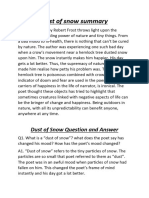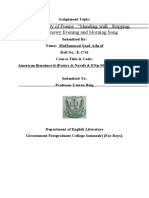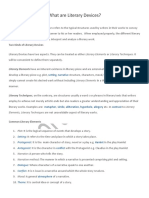0 ratings0% found this document useful (0 votes)
9 viewsAnalyze Trees by Joyce Kilmer
Analyze Trees by Joyce Kilmer
Uploaded by
phuongnghile2009Copyright:
© All Rights Reserved
Available Formats
Download as DOCX, PDF, TXT or read online from Scribd
Analyze Trees by Joyce Kilmer
Analyze Trees by Joyce Kilmer
Uploaded by
phuongnghile20090 ratings0% found this document useful (0 votes)
9 views3 pagesOriginal Title
ANALYZE TREES BY JOYCE KILMER
Copyright
© © All Rights Reserved
Available Formats
DOCX, PDF, TXT or read online from Scribd
Share this document
Did you find this document useful?
Is this content inappropriate?
Copyright:
© All Rights Reserved
Available Formats
Download as DOCX, PDF, TXT or read online from Scribd
Download as docx, pdf, or txt
0 ratings0% found this document useful (0 votes)
9 views3 pagesAnalyze Trees by Joyce Kilmer
Analyze Trees by Joyce Kilmer
Uploaded by
phuongnghile2009Copyright:
© All Rights Reserved
Available Formats
Download as DOCX, PDF, TXT or read online from Scribd
Download as docx, pdf, or txt
You are on page 1of 3
Name: Lê Phương Nghi ( Nelly )
Trees by Joyce Kilmer
I think that I shall never see
A poem lovely as a tree
A tree whose hungry mouth is prest
Against the earth’s sweet flowing breast.
A tree that looks at God all day
And lifts her leafy arms to pray
A tree that may in summer wear
A nest of robins in her hair
Upon whose bosom snow has rain
Who intimately lives in rain
Poems are made by fools like me
But only God can make a tree.
A speaker in Joyce Kilmer's "Trees" passionately asserts that no work of art,
particularly a tree, can surpass one of God's creations. The speaker of the poem
declares at the outset that he has never seen a poem more lovely than a tree. He thinks
that humankind is incapable of creating anything more superior than what God has
created. The kind of tree he envisions is the subject of the words that follow. It will be
closely linked to the planet and its constituent elements. Summertime will see birds
building their nests in the branches, while winter will bring soft snow to the tree's
"bosom." The speaker of the poem explains in its conclusion that nothing that
humanity creates would ever be more beautiful than what is currently in existence.
The poem by Joyce Kilmer consists of twelve lines divided into six couplets, or sets of
two lines. Kilmer has decided to keep the poem's rhyme scheme constant at aa bb cc
dd ee aa. Additionally, the poet has chosen to employ a metrical pattern that is nearly
wholly unifying. With the exception of one, every line is written in iambic tetrameter.
The piece's eleventh line eliminates the unstressed syllable after starting on a stressed
one.
With the theme of nature and trees, the poem opens with the first four lines:
I think that I shall never see
A poem lovely as a tree
A tree whose hungry mouth is prest
Against the earth’s sweet flowing breast.
The opening couplet opens with a straightforward but powerful prognosis. Without
providing any background information, Kilmer's speaker states that he will "never
see / A poem lovely as a tree." One thing that makes this piece intriguing is how
simple and easy to understand his sentences are. He is certain that every tree on the
earth is more significant and "lovely" than even the most exquisite sonnet. The
alliteration of the words "shall" and "see" adds even more rhythm to these sentences.
He shifts in the next few lines from a broad description of all trees to a single species
or variety. He is referring to a tree that has its "hungry mouth...prest" to the ground. It
is becoming sweeter off the "earth's...breast" as a result of absorbing the nutrients
from the soil. These words blatantly employ personification, a device the author
employs throughout the entire poem. It's applied to try and give the impression that
something inanimate is more real. A human subject makes it easier for the reader to
relate to it. The human connection is crucial because, in addition to making the tree
more approachable by personifying it, humans frequently elevate themselves in order
to establish a connection with nature.
Next, in the third couplet, the speaker develops the character of this kind of tree
further:
A tree that looks at God all day
And lifts her leafy arms to pray
A tree that may in summer wear
A nest of robins in her hair.
It is always facing God because of its location on the earth and its relatively stable
structure. It “looks at God all day.” The tree benefits from this fact. It is both more
and less human because of its religiosity. Like most people, the tree connects with
God, but its devotion to him is greater than anyone's could ever be. The speaker
addresses the evergreen plant as "her" in the following lines. This directly relates to
the more expansive representation of "Mother Earth," a dominant female figure on the
world—or, to be more precise, the planet itself—that is in charge of the development
and maintenance of life. She spends all day looking to God, and “lifts” her “arms to
pray.” The tree is brought back to Earth in the following two sentences. Even though
"she" is loyal, "she" is still a part of the planet. There will be a "nest of robins in her
hair" in the "Summer." The purpose of this amusing line is to make the reader like the
tree. Around the tree, the real, everyday world is still in operation.
The speaker goes on to discuss how the seasons affect the plant in the second-to-last
couplet:
Upon whose bosom snow has rain
Who intimately lives in rain
Poems are made by fools like me
But only God can make a tree.
At this stage, the "tree" has become rather specific. It has changed from being a
universal, all-encompassing emblem to a particular plant that the speaker can clearly
remember. There will be "snow" on the tree's "bosom" when winter arrives. It will
softly rest there, not causing any damage to "her" branches. The speaker mentions the
rain as she wraps up her descriptions. This element, like the sun and the snow, does
nothing to harm or interfere with the tree. Like "she" does with everything else, "she"
lives "intimately with rain." The speaker returns to the piece's central idea—that art
cannot equal nature—in the last two lines. He says that this is because of the nature of
humanity itself. One of God's creatures is superior to any man or woman.
In conclusion, Trees by Joyce Kilmer depicts a stunning natural setting, with each tree
having a unique appeal that embodies the vitality of the entire universe. The poem
marvels at the world's immense intricacy while celebrating its creation by the
Christian God.
You might also like
- Lucy Jamaica KincaidDocument16 pagesLucy Jamaica KincaidJacqueline PerhachNo ratings yet
- 201 Swedish Verbs Fully Conjugated in All The Tenses Alphabetically ArrangedDocument71 pages201 Swedish Verbs Fully Conjugated in All The Tenses Alphabetically ArrangedChris100% (4)
- (Cambridge Greek and Latin Classics) R. L. Hunter - Apollonius of Rhodes - Argonautica Book III-Cambridge University Press (1989)Document139 pages(Cambridge Greek and Latin Classics) R. L. Hunter - Apollonius of Rhodes - Argonautica Book III-Cambridge University Press (1989)Matías Ezequiel PughNo ratings yet
- A Late Walk (Robert Frost)Document9 pagesA Late Walk (Robert Frost)Nur Amirah Hamzah100% (3)
- "Trees" by Joyce KilmerDocument2 pages"Trees" by Joyce KilmerJochelleNo ratings yet
- Trees by Joyce KilmerDocument3 pagesTrees by Joyce KilmerRony SahaNo ratings yet
- Trees by Joyce KilmerDocument4 pagesTrees by Joyce KilmerEra SantiagoNo ratings yet
- Trees SummaryDocument1 pageTrees Summarytejastayade519No ratings yet
- TreesDocument4 pagesTreeswinbinsonNo ratings yet
- Story Analysis Lit 05 TreesDocument3 pagesStory Analysis Lit 05 Treesss.monteNo ratings yet
- Joyce KilmerDocument3 pagesJoyce KilmerdevosioNo ratings yet
- Poem TreesDocument1 pagePoem TreesCj LuceroNo ratings yet
- Trees by Joyce Kilmer ReflectionDocument2 pagesTrees by Joyce Kilmer ReflectionMonica Reign MacarangNo ratings yet
- Group 2: 1. Afif Nurfadila 2. Alya Fadhilah 3. Dandre Dafasetya 4. M.Rizki Rahmadiana 5. Raden Roro CDocument12 pagesGroup 2: 1. Afif Nurfadila 2. Alya Fadhilah 3. Dandre Dafasetya 4. M.Rizki Rahmadiana 5. Raden Roro CAlya FadhilahNo ratings yet
- Creative Writing: Elements, Techniques, and Literary Devices in Specific Forms of PoetryDocument8 pagesCreative Writing: Elements, Techniques, and Literary Devices in Specific Forms of Poetrydon't mindmeNo ratings yet
- VAC Eco and Lit, On Killing A TreeDocument6 pagesVAC Eco and Lit, On Killing A Treepsy22040No ratings yet
- English Print 3Document23 pagesEnglish Print 3Shreyosi KarNo ratings yet
- Critical Appreciation and ThemesDocument2 pagesCritical Appreciation and ThemesRifa Kader Disha0% (1)
- Dust of Snow CL-WPS OfficeDocument5 pagesDust of Snow CL-WPS Officecherry guptaNo ratings yet
- Sample - Planting A SequoiaDocument4 pagesSample - Planting A SequoiaSonia MoNo ratings yet
- Dust of Snow (Summary)Document8 pagesDust of Snow (Summary)Remya SNo ratings yet
- LiteratureDocument5 pagesLiteratureDarenJayBalboa100% (1)
- Dust of Snow IntroductionDocument6 pagesDust of Snow IntroductionSelanMable100% (1)
- Frost "Birches"Document5 pagesFrost "Birches"Alicia Y. WeiNo ratings yet
- A Thing of BeautyDocument5 pagesA Thing of Beautytrishach1994No ratings yet
- Common AnswersDocument2 pagesCommon AnswersUjjwal goswamiNo ratings yet
- Assignment of American LiteratureDocument12 pagesAssignment of American LiteratureMuhammad Saad AshrafNo ratings yet
- 253download. - 0POEM 1 CLASS X ENGLISHDocument4 pages253download. - 0POEM 1 CLASS X ENGLISHRemya SNo ratings yet
- The GardenDocument3 pagesThe GardenBIO SCOPENo ratings yet
- The Trees SummaryDocument7 pagesThe Trees Summarymonishacm1010No ratings yet
- Dust of Snow Question and AnswerDocument4 pagesDust of Snow Question and AnswerAnushka TiwariNo ratings yet
- Voice of The Rain NotesDocument6 pagesVoice of The Rain NotescatchshreyyyNo ratings yet
- 2 Stopping by Woods On A Snowy EveningDocument2 pages2 Stopping by Woods On A Snowy EveningSylvaen Wsw0% (1)
- Binsey PoplarsDocument3 pagesBinsey PoplarsawotundunoluwatodimuNo ratings yet
- The Dust of Snow PDFDocument7 pagesThe Dust of Snow PDFtrevin79saiNo ratings yet
- Trees - NoteDocument2 pagesTrees - NoteMalachi is survivinNo ratings yet
- Emily DickinsonDocument3 pagesEmily DickinsonAnthony RivasNo ratings yet
- Literary Devices UsedDocument4 pagesLiterary Devices UsedRomyross JavierNo ratings yet
- Dust of SnowDocument1 pageDust of SnowPriyanshi VermaNo ratings yet
- Elementstechniquesandliterarydevicesin 220510070421 734c3790Document33 pagesElementstechniquesandliterarydevicesin 220510070421 734c3790Marian Louise Rubio ReligiosoNo ratings yet
- Gabriela Sorodoc - IlaDocument3 pagesGabriela Sorodoc - IlaAbīNo ratings yet
- The Trees - Compressed Cbse Support DocumentDocument6 pagesThe Trees - Compressed Cbse Support DocumentMayank SinghNo ratings yet
- PoemDocument14 pagesPoemSaleh hayatNo ratings yet
- Eng Lit Project 2Document3 pagesEng Lit Project 2Raj MallickNo ratings yet
- TREES POEM BY JOYCE KILMkilmerDocument6 pagesTREES POEM BY JOYCE KILMkilmerKirti Sharma (Shanaya)No ratings yet
- Answer Man Wat Anak2Document1 pageAnswer Man Wat Anak2Qushoy Al IhsaniyNo ratings yet
- Asg202402122132448157 1 193-1Document5 pagesAsg202402122132448157 1 193-1ayushm3579No ratings yet
- Meg-1 2018-19Document10 pagesMeg-1 2018-19AnjnaKandariNo ratings yet
- Joyce Kilmer's Tree A Biographical and Moralistic ExplorationDocument6 pagesJoyce Kilmer's Tree A Biographical and Moralistic ExplorationYouk Nowwho IamsurelyNo ratings yet
- 10 English - Dust of Snow - NotesDocument2 pages10 English - Dust of Snow - NotesGaurav Singh100% (1)
- On Killing A TreeDocument3 pagesOn Killing A Treekarthika4a100% (1)
- Tree Symbol:-: Our Casuarina Tree - Toru DuttDocument5 pagesTree Symbol:-: Our Casuarina Tree - Toru DuttMEGHANA MB100% (2)
- Analyzing The Three Kings' in Light of Romantic IdealsDocument4 pagesAnalyzing The Three Kings' in Light of Romantic Idealsstephanie.ravalNo ratings yet
- Shiwali Kumari - Dust of Snow - 10'daffodils'-32Document10 pagesShiwali Kumari - Dust of Snow - 10'daffodils'-32shiwali689No ratings yet
- English Essay-Report To Wordswoth and LamentDocument3 pagesEnglish Essay-Report To Wordswoth and LamentChyrsella VerenaNo ratings yet
- Study Material On On KILLING A TREE For Class IX 2020-21Document3 pagesStudy Material On On KILLING A TREE For Class IX 2020-21Animesh AdakNo ratings yet
- The TreesDocument8 pagesThe TreesMili Sarkar100% (1)
- 1.0 Theme: Nature Poem 1Document11 pages1.0 Theme: Nature Poem 1Safwan AliasNo ratings yet
- Trees: Volume Four of the Series Nature WorksFrom EverandTrees: Volume Four of the Series Nature WorksNo ratings yet
- T&A - Payroll - ENERO2024 - Sevilla - 04 - 02Document1 pageT&A - Payroll - ENERO2024 - Sevilla - 04 - 02Joaquín TusmuertosNo ratings yet
- Philippine Literature During The American Colonial Period: American and Japanese PeriodsDocument3 pagesPhilippine Literature During The American Colonial Period: American and Japanese PeriodsShayne Herrera IINo ratings yet
- AQA Power and Conflict GCSE Revision Guide LADocument49 pagesAQA Power and Conflict GCSE Revision Guide LAderaw11557No ratings yet
- What Are Literary DevicesDocument10 pagesWhat Are Literary DevicesCristiano SamarooNo ratings yet
- Friends, Romans, Countrymen, Lend Me Your EarsDocument3 pagesFriends, Romans, Countrymen, Lend Me Your EarsPanache Z0% (1)
- M.A. English 1sem. - PDFDocument1 pageM.A. English 1sem. - PDFFood ingredientNo ratings yet
- 534ca5f5-3559-40f3-b587-158c47441561Document340 pages534ca5f5-3559-40f3-b587-158c47441561Nikola ĐurićNo ratings yet
- The Journey (Rida)Document4 pagesThe Journey (Rida)Ume lailaNo ratings yet
- Character Portraits: Albus DumbledoreDocument4 pagesCharacter Portraits: Albus DumbledoreYuliana PavlyshynNo ratings yet
- Can Subaltern Women Speak? Where Is Aime Cesaire's "Sycorax"?Document15 pagesCan Subaltern Women Speak? Where Is Aime Cesaire's "Sycorax"?Kavisha AlagiyaNo ratings yet
- Is Childrens Literature Dead ExtractDocument2 pagesIs Childrens Literature Dead ExtractKRISHNANo ratings yet
- OceanofPDF - Com The Legend of Sleepy Hollow - Bo HamptonDocument56 pagesOceanofPDF - Com The Legend of Sleepy Hollow - Bo HamptonTishefunmi OgunmoyeNo ratings yet
- Dam Zagajewski: Jump To Navigationjump To SearchDocument3 pagesDam Zagajewski: Jump To Navigationjump To SearchlolabelayonNo ratings yet
- 1.5 Historical Analysis of Pigafetta's Account of Magellan's Arrival in The Philippines - GEC 002-BALSCM12S1 - Readings in Philippine HistoryDocument3 pages1.5 Historical Analysis of Pigafetta's Account of Magellan's Arrival in The Philippines - GEC 002-BALSCM12S1 - Readings in Philippine Historymvaungriano01No ratings yet
- Lesson 8 Summary WritingDocument7 pagesLesson 8 Summary WritingGuttyon100% (11)
- ENG362 Bankim ChandraDocument3 pagesENG362 Bankim ChandraSanjida NoorNo ratings yet
- Of Mirrors and Bell Jars - Heterotopia and Liminal Spaces As Reconfigurations of Female Identity in Sylvia PlathDocument16 pagesOf Mirrors and Bell Jars - Heterotopia and Liminal Spaces As Reconfigurations of Female Identity in Sylvia PlathAlexandreNo ratings yet
- Analysis of The Stone-ChatDocument6 pagesAnalysis of The Stone-ChatAlmass MazharNo ratings yet
- Aninspectorcalls Essay QuestionsDocument4 pagesAninspectorcalls Essay QuestionsAzrin AzNo ratings yet
- My Sister Betty - SummaryDocument1 pageMy Sister Betty - Summarykirangs02975% (4)
- The InterviewDocument3 pagesThe InterviewParth AgrawalNo ratings yet
- Characteristics of African LiteratureDocument2 pagesCharacteristics of African LiteratureJoela Castil80% (5)
- Exemple de Conclusion de Dissertation Sur Le RomanDocument4 pagesExemple de Conclusion de Dissertation Sur Le RomanPaperWritersCollegeCanadaNo ratings yet
- Toni Morrison Thesis PDFDocument4 pagesToni Morrison Thesis PDFgjh9pq2a100% (1)
- Rizal's Work and LiteracyDocument1 pageRizal's Work and LiteracyJubell Ann RamientasNo ratings yet
- ARAB Network OfficialDocument455 pagesARAB Network OfficialShrife AdelNo ratings yet
- Psalm 127 v1-2 - "Unless"Document1 pagePsalm 127 v1-2 - "Unless"Malcolm CoxNo ratings yet

























































































